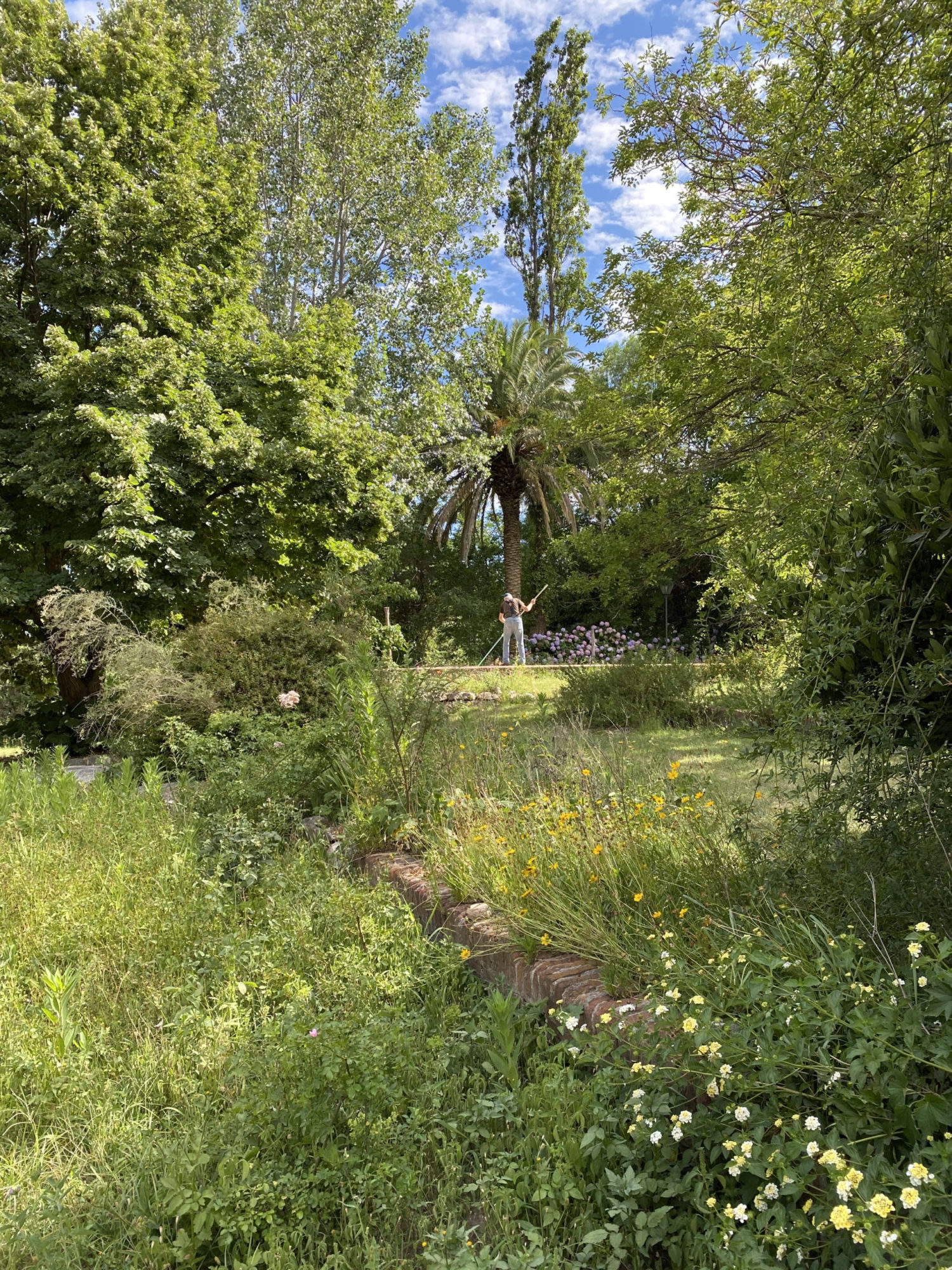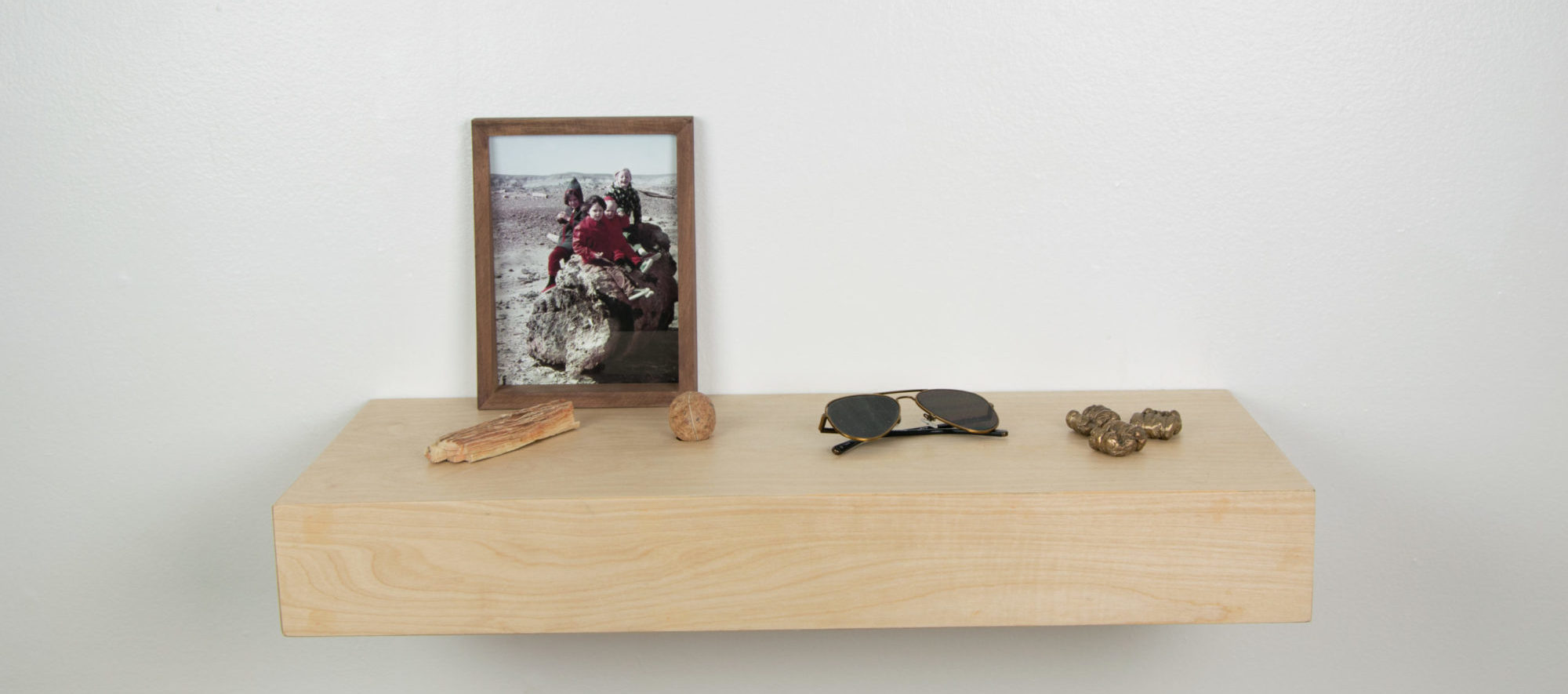Alexa Horochowski: Nomeacuerdo (I-don’t-remember-land)

Alexa Horochowski, Lava Fold – Horizontal, 2021, dye sublimation, chiffon, 58”x 86” inches as installed [photo: Emma Beatrez; courtesy of Alexa Horochowski/HAIR+NAILS, Minneapolis]
Share:
Alexa Horochowski’s exhibition, Nomeacuerdo (I-don’t-remember-land), at Hair+Nails Contemporary Art floats through poetic explorations of personal history, political movements, deep time, and social collaborations between humans and animals. Landscapes, in which these narratives unfold and become entangled, are central to the works throughout the two-story exhibition space. Central among these landscapes is Argentina: the artist’s childhood home, and the place her father still lives.
In a photo taken by her father, Alejandro Horochowski, the artist and her siblings lunching on a petrified tree in Patagonia, 1972 [courtesy of Alexa Horochowski / HAIR+NAILS, Minneapolis]
In a photo taken by Alexa Horochowski, her father is cleaning the pool, Los Molles, Argentina, January 2020 [courtesy of Alexa Horochowski/HAIR+NAILS, Minneapolis]
During the 20th century, Argentina received millions of immigrants fleeing war-torn Europe—two of whom were Horochowski’s Ukrainian paternal grandparents. After World War II, the Argentinian government conspired with the SS to offer safe passage and new identities to Nazi leaders fleeing the consequences of their genocidal ambitions. Remnants of this history can be felt, though never explicitly seen, in Horochowski’s exhibition. We are still reckoning with such 20th-century events—with industrialism, imperialism, fascism, and the movement of peoples and materials across borders and over landscapes—a reality summarized by a hand-embroidered flag, hanging opposite the gallery’s entrance, that reads SCHADENFREUDE.
Alexa Horochowski, Nomeacuerdo (I-don’t-remember-land), installation view, 2021 [photo: Emma Beatrez; courtesy of Alexa Horochowski/HAIR+NAILS, Minneapolis]
Alexa Horochowski, Lava Fold – Vertical, 2021, dye sublimation print, chiffon, 84”x 64” inches as installed [photo: Emma Beatrez; courtesy of Alexa Horochowski/HAIR+NAILS, Minneapolis]
The exhibition title comes from a poem by Argentinian Maria Elena Walsh: “In the country of I-don’t-remember-land / I take three steps and I’m lost.” 1 To be lost in an unrememberable landscape is to be swallowed by the geological memories of mountains, rocks, rivers, and shores, before me, before modernity, before history; it is to be eclipsed by the sublimity of time. Hawaiian lava flows printed as rectangles on much larger sheets of chiffon repeat throughout the gallery’s first floor. Horochowski has loosely shaped the excess material to mimic in fabric the folds of lava appearing in each image. As air circulates, the draperies ripple and balloon, animating the volcanic rock. Bodies in the space further displace the flow of air as they navigate the exhibition, redirecting currents, changing each drapery’s dance. The pre-Socratics and Greek stoics located the metaphysical life force in air, in breath—which they called pneuma. These shimmering works represent the transmigration of the breath of life into rock. Volcanic eruptions introduce minerals to a landscape, rejuvenating the soil over time. However, the rejuvenation of soil through fire is also the destruction of life in the moment, as heat, flame, and ash blanket a landscape before solidifying as a new, jagged expanse. For me, this process recalls the fascist idea of cleansing by fire, much as the Holocaust was meant to cleanse the German populace and, by extension, their nation. But, in these works, small green shoots peek through the volcanic rock—life finds a way, even in the short term. Is the breath of life the Earth exhaling molten rock? Or the little green shoots that defy the flame? Is the perseverance of life also indicative of the perseverance of fascism?
In the basement, a two-channel video, La Maravilla (2021), situates the 2019 protests in Concepción, Chile, alongside cohabitation involving humans, sea lions, seagulls, and stray dogs. The dogs, known as quiltros, freely roam the city, and people honor them with food, shelter, and even burials, as depicted in one panning shot of a graveyard and row of shack-like houses. And in turn, the quiltros honor the people by joining in protests. A flag opposite the video commemorates one such dog, Negro Matapacos, meaning “Blackie the Cop Killer,” who protected Chilean protestors from police violence. Horochowski’s slowed-down footage is striking: Protestors march, chant, and sing as quiltros navigate the crowd. Military vehicles arrive with water cannons and tear gas to stalk and harass nonviolent demonstrators, and after nightfall, fires burn in the streets. These protests—named in Chile El Estallido Social, or The Social Outbreak—opposed high transportation costs, high costs of living, and inequity throughout the country. The violent response from police and military, which entailed the killings of several and maimings of many, exacerbated tensions between the people and the Chilean government.
For centuries, European philosophers divided the world along binaries: Conscious vs. nonconscious; living vs. nonliving; animate vs. inert. Over the last two decades, interdisciplinary groups have banded together under the banner of New Materialism to disassemble the hierarchies that follow from these binaries. All things have an animated potential. Our bodies collaborate with minerals and bacteria to sustain our conscious awareness. That is to say, consciousness is embodied—we are not a hierarchy. This horizontality is a facet of anti-fascist resistance. Power in authoritarian governments flows from the individuals who situate themselves at the top. The people occupy a mass at the bottom of this pyramid scheme, where rights arrive by a trickle, while police and military function to enforce the will from on high. Collective action needs no central leader or chain of command to be successful; horizontal organization and collaboration give the people a voice, celebrating the ideal of democracy.
Alexa Horochowski, La Maravilla, 2021, two-channel video projection, 35 minutes/28 minutes [photo: Emma Beatrez; courtesy of Alexa Horochowski/HAIR+NAILS, Minneapolis]
As protestors march through the camera frame, they pass buildings and pillars covered in graffiti, most of it text in support of protestors, denigrating police, and demanding justice. The image of an opened eye repeats over and over, bearing witness even as police attempt to take sight away with their rubber bullets and tear gas. These social and political realities transmuted into graffiti reflect a red-tinted chiffon drapery upstairs, rippling with 10,000-year-old hand-stencils from Argentine Patagonia. Ancient artists packed pigment into hollow reeds and blew color across their hands to leave hand shadows on the cave wall, fossilizing their breath, their pneuma. Spray paint cans are a technological adaptation of packing pigment into a hollow stick and blowing. Now, we build our own caves, and the bigger they get, the more those who hold power become the puppet masters in Plato’s allegory of the cave. The graffitied eye is the perseverance of vision; it is the people seeing through shadow-play.
Alexa Horochowski, Nomeacuerdo (I-don’t-remember-land), installation view, 2021 [photo: Emma Beatrez; courtesy of Alexa Horochowski/HAIR+NAILS, Minneapolis]
Back on the first floor, a shelf holds a series of objects: a photograph of Horochowski as a child with her family in Patagonia, a piece of petrified wood; a boleadora; and two sculptures, one a set of cast bronze packing peanuts, the other a pair of aviator sunglasses with a pane of obsidian replacing one lens. In El Estallido Social, protestors who lost eyes often returned wearing eyepatches; others wore them in solidarity, undeterred by the threat of violence. Theorist Ariella Aïsha Azoulay proposes that the only way to counter imperialism is to live by the moto: “Here I am; kill me if you wish.”2 This tactic has been used by Indigenous peoples around the world to force imperialists and colonialists to confront the inhumanity of their projects. Furthermore, Azoulay suggests we must emulate Indigenous resistance. 3 The boleadora, a small ball-shaped rock with a trench traveling its circumference was a Tehuelche tool for hunting, later appropriated by the Mapuche to fight Spanish cavalry in the 236-year Arauco War.
Horochowski’s exhibition extends Azoulay through the boleadora, eyepatch-aviators, human-animal cohabitation and collaboration, to propose that the social outbreak is not merely human protest against authoritarian and exclusionary political structures. We must horizontalize and collectivize with animals and plants, with trees and lava flows, with cycles of mineralization. We must be willing to forget modernity, to forget ourselves, to become lost in the depths of time and space, in the sublimity of the land. There is freedom in forgetting.
References
| ↑1 | Maria Elena Walsh, “El País de Nomeacuerdo” (1967), quoted by Alexa Horochowski in the gallery guide for Nomeacuerdo (I-don’t-remember-land). |
|---|---|
| ↑2 | Ariella Aïsha Azoulay, interviewed by Hrag Vartanian, “Connecting Museums, Modern Art, Colonialism, and Violence,” Hyperallergic, March 11, 2020, online. |
| ↑3 | Ariella Aïsha Azoulay, Potential History: Unlearning Imperialism (London: Verso, 2019). |





